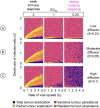Effects of virus-induced immunogenic cues on oncolytic virotherapy
- PMID: 39572761
- PMCID: PMC11582614
- DOI: 10.1038/s41598-024-80542-8
Effects of virus-induced immunogenic cues on oncolytic virotherapy
Abstract
Oncolytic virotherapy is a promising form of cancer treatment that uses viruses to infect and kill cancer cells. In addition to their direct effects on cancer cells, the viruses stimulate various immune responses partly directed against the tumour. Efforts are made to genetically engineer oncolytic viruses to enhance their immunogenic potential. However, the interplay between tumour growth, viral infection, and immune responses is complex and not fully understood, leading to variable and sometimes counterintuitive therapeutic outcomes. Here, we employ a spatio-temporal model to shed more light on this interplay. We investigate systematically how the properties of virus-induced immunogenic signals (their half-life, rate of spread, and potential to promote T-cell-mediated cytotoxicity) affect the therapeutic outcome. Our simulations reveal that strong immunogenic signals, combined with faster diffusion rates, improve the spread of immune activation, leading to better tumour eradication. However, replicate simulations suggest that the outcome of virotherapy is more stochastic than generally appreciated. Our model shows that virus-induced immune responses can interfere with virotherapy, by targeting virus-infected cancer cells and/or by impeding viral spread. In the presence of immune responses, the mode of virus introduction is important, with systemic viral delivery throughout the tumour yielding the most favourable outcomes. The timing of virus introduction also plays a critical role; depending on the efficacy of the immune response, a later start of virotherapy can be advantageous. Overall, our results emphasise that the rational design of oncolytic viruses requires optimising virus-induced immunogenic signals and strategies that balance viral spread with immune activity for improved therapeutic success.
Keywords: Immune response; Immunogenic molecules; Spatial model; Stochastic outcome; Therapy failure.
© 2024. The Author(s).
Conflict of interest statement
Declarations. Competing interests: The authors declare no competing interests.
Figures







Similar articles
-
Modelling the spatial dynamics of oncolytic virotherapy in the presence of virus-resistant tumour cells.PLoS Comput Biol. 2022 Dec 6;18(12):e1010076. doi: 10.1371/journal.pcbi.1010076. eCollection 2022 Dec. PLoS Comput Biol. 2022. PMID: 36473017 Free PMC article.
-
Oncolytic virotherapy as promising immunotherapy against cancer: mechanisms of resistance to oncolytic viruses.Future Oncol. 2022 Jan;18(2):245-259. doi: 10.2217/fon-2021-0802. Epub 2021 Nov 25. Future Oncol. 2022. PMID: 34821517 Review.
-
Novel Oncolytic Herpes Simplex Virus 1 VC2 Promotes Long-Lasting, Systemic Anti-melanoma Tumor Immune Responses and Increased Survival in an Immunocompetent B16F10-Derived Mouse Melanoma Model.J Virol. 2021 Jan 13;95(3):e01359-20. doi: 10.1128/JVI.01359-20. Print 2021 Jan 13. J Virol. 2021. PMID: 33177208 Free PMC article.
-
Molecular Circuits of Immune Sensing and Response to Oncolytic Virotherapy.Int J Mol Sci. 2024 Apr 25;25(9):4691. doi: 10.3390/ijms25094691. Int J Mol Sci. 2024. PMID: 38731910 Free PMC article. Review.
-
Combining oncolytic virotherapy and tumour vaccination.Cytokine Growth Factor Rev. 2010 Apr-Jun;21(2-3):143-8. doi: 10.1016/j.cytogfr.2010.02.009. Epub 2010 Mar 11. Cytokine Growth Factor Rev. 2010. PMID: 20226716 Review.
References
-
- Kelly, E. & Russell, S. J. History of oncolytic viruses: Genesis to genetic engineering. Mol. Ther.15, 651–659 (2007). - PubMed
MeSH terms
LinkOut - more resources
Full Text Sources
Medical

